Profile
Blog
Photos
Videos
Travel Blog of the Gaps
Guten Tag, Blogonauts!
Normally I allow myself to get to know a new city on my own ... wandering about with a tourists' guidebook and a map, letting my curiosity determine my course.
But while I was employing this haphazard habit soon after my arrival in Munich, I heard someone say, "Ah, there's someone with Rick Steves' guidebook! That's a sure sign of an English speaker."
And that's how I was introduced to Lenny, of Lenny's Bike Tours, who talked me into joining the ad hoc tour group the following morning.
There were about 10 of us, led by an Australian ex-pat who has only lived in Munich for a few months. The tour offers only the slimmest introduction to Munich history, and most of the participants were Americans (including one family from Connecticut). Nonetheless, we had a good time, and I got to see a broader cross-section of the city than I would have toodling about solo and on foot.
Munich's town center definitely lies at Marienplatz. On one side stands the Altes Rathaus (Old Town Hall), which although its construction was begun in the 15th century, looks newer because it has been largely rebuilt to repair wartime bombing damage. And nearby stands the larger and more ornate Neues Rathaus (New Town Hall). Although it is only a bit over a century old, because it was built in the Neo-Gothic style reminiscent of old castles and cathedrals, the Neues Rathaus looks far older than than its elder cousin.
The Neues Rathaus, is best known for its Glockenspiel, which 2-3 times daily plays a traditional Bavarian music while its pre-Disney animatronics portray two events: First, the wedding of Duke Wilhelm V. to Renata of Lorraine in 1568. (The glockenspiel's top level shows a jousting tournament where eventually the Bavarian knight wins the day.) And second, the dancing the coopers (barrel makers) performed in an effort to ward off the plague.
These animations commemorate events several hundred years old, but the Glockenspiel was not completed until around 1900, so the clockwork evokes an older time than most folks would imagine.
From there the tour group mounted our bikes in Viktualienmarkt and pedaled past the Residenz, the former royal Bavarian palace. (Later I toured the restored areas of the Residenz.) Nearby were sites where a young Hitler provoked a riot and was arrested. He spent only a few months in prison, which was long enough for him to write "Mein Kampf."
The bicyclers continued on to the Englischer Garten, one of the largest municipal parks in all of Europe. On our way to lunch, we traversed the pathway through the Nudist Meadow. Germans have a reputation around Europe for their ease regarding public nudity. Then we broke for Mittagessen (lunch) at the Chinese Tower, which is surrounded by a 6000-seat Biergarten.
Where a fast-flowing creek enters the Englischer Garten, there is a consistent wave that has been commandeered by the city's surfers. This is indeed a dangerous sport, but there is no denying the skill and grace on display.
After 3½ hours of easy pedaling and snarfing down food, we wound our way back through the city to drop off the bikes. So long as you don't expect an in-depth history lesson, the tour is definitely worth €10 (plus a tip).
Normally I allow myself to get to know a new city on my own ... wandering about with a tourists' guidebook and a map, letting my curiosity determine my course.
But while I was employing this haphazard habit soon after my arrival in Munich, I heard someone say, "Ah, there's someone with Rick Steves' guidebook! That's a sure sign of an English speaker."
And that's how I was introduced to Lenny, of Lenny's Bike Tours, who talked me into joining the ad hoc tour group the following morning.
There were about 10 of us, led by an Australian ex-pat who has only lived in Munich for a few months. The tour offers only the slimmest introduction to Munich history, and most of the participants were Americans (including one family from Connecticut). Nonetheless, we had a good time, and I got to see a broader cross-section of the city than I would have toodling about solo and on foot.
Munich's town center definitely lies at Marienplatz. On one side stands the Altes Rathaus (Old Town Hall), which although its construction was begun in the 15th century, looks newer because it has been largely rebuilt to repair wartime bombing damage. And nearby stands the larger and more ornate Neues Rathaus (New Town Hall). Although it is only a bit over a century old, because it was built in the Neo-Gothic style reminiscent of old castles and cathedrals, the Neues Rathaus looks far older than than its elder cousin.
The Neues Rathaus, is best known for its Glockenspiel, which 2-3 times daily plays a traditional Bavarian music while its pre-Disney animatronics portray two events: First, the wedding of Duke Wilhelm V. to Renata of Lorraine in 1568. (The glockenspiel's top level shows a jousting tournament where eventually the Bavarian knight wins the day.) And second, the dancing the coopers (barrel makers) performed in an effort to ward off the plague.
These animations commemorate events several hundred years old, but the Glockenspiel was not completed until around 1900, so the clockwork evokes an older time than most folks would imagine.
From there the tour group mounted our bikes in Viktualienmarkt and pedaled past the Residenz, the former royal Bavarian palace. (Later I toured the restored areas of the Residenz.) Nearby were sites where a young Hitler provoked a riot and was arrested. He spent only a few months in prison, which was long enough for him to write "Mein Kampf."
The bicyclers continued on to the Englischer Garten, one of the largest municipal parks in all of Europe. On our way to lunch, we traversed the pathway through the Nudist Meadow. Germans have a reputation around Europe for their ease regarding public nudity. Then we broke for Mittagessen (lunch) at the Chinese Tower, which is surrounded by a 6000-seat Biergarten.
Where a fast-flowing creek enters the Englischer Garten, there is a consistent wave that has been commandeered by the city's surfers. This is indeed a dangerous sport, but there is no denying the skill and grace on display.
After 3½ hours of easy pedaling and snarfing down food, we wound our way back through the city to drop off the bikes. So long as you don't expect an in-depth history lesson, the tour is definitely worth €10 (plus a tip).
- comments




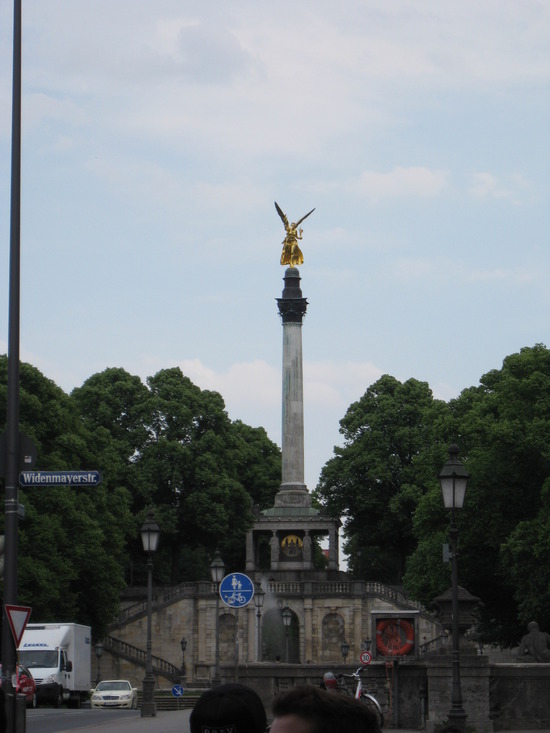

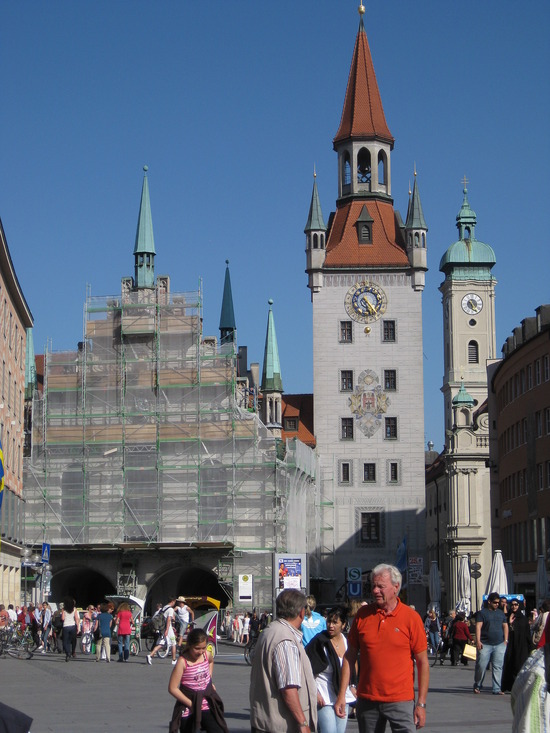
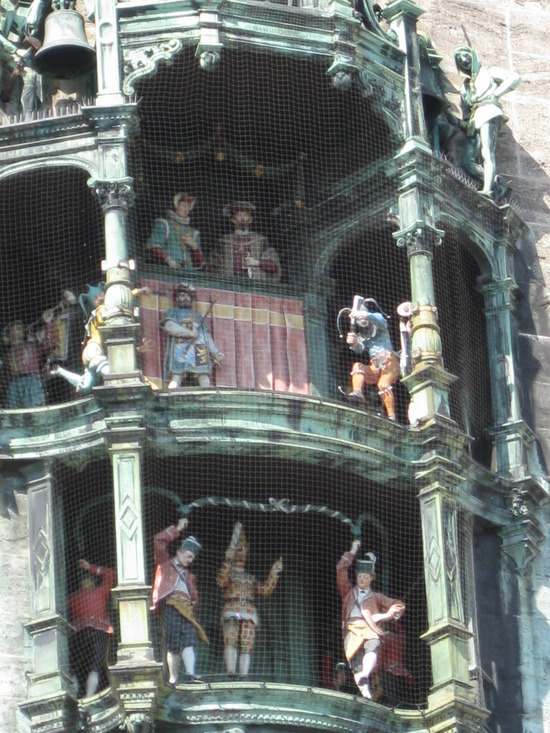
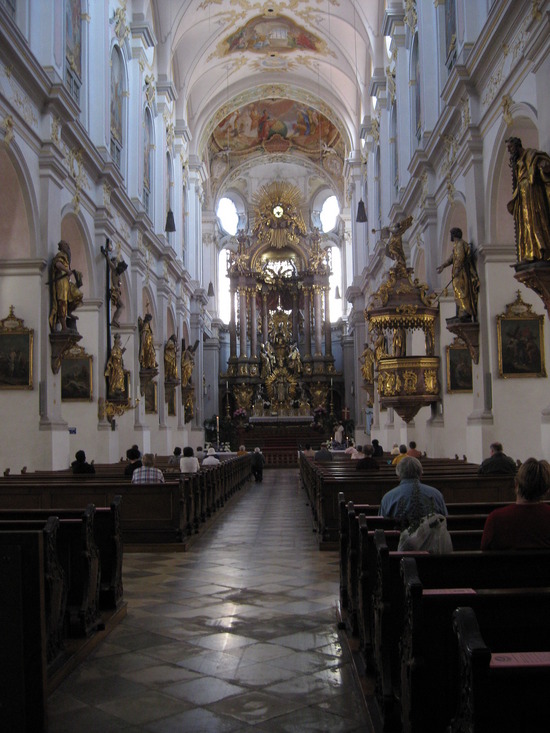
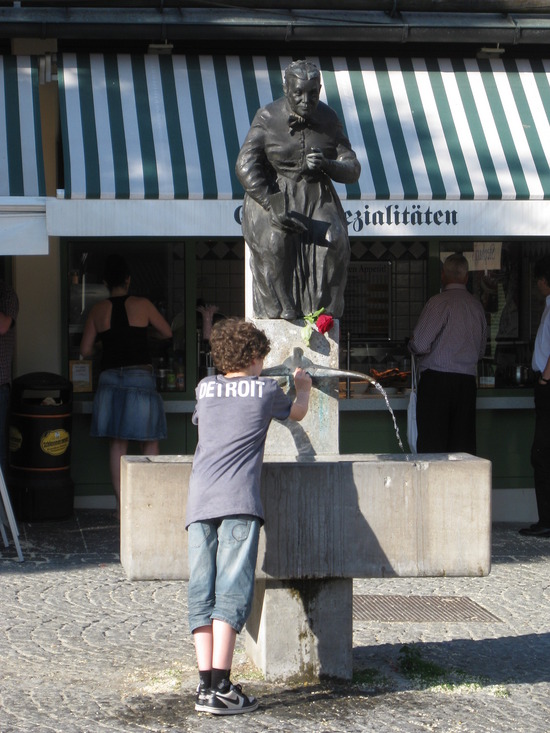
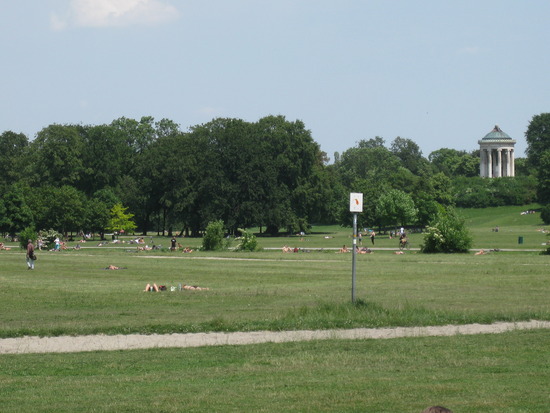
Dee Tucker Hi Larry, how well I remember the Glockenspiel in Munich when my family and I were stationed in Germany. Thanks for bringing one of the many memories of my stay overseas.
annav When we were in Marienplatz it was filled with a pride festival--very fun.